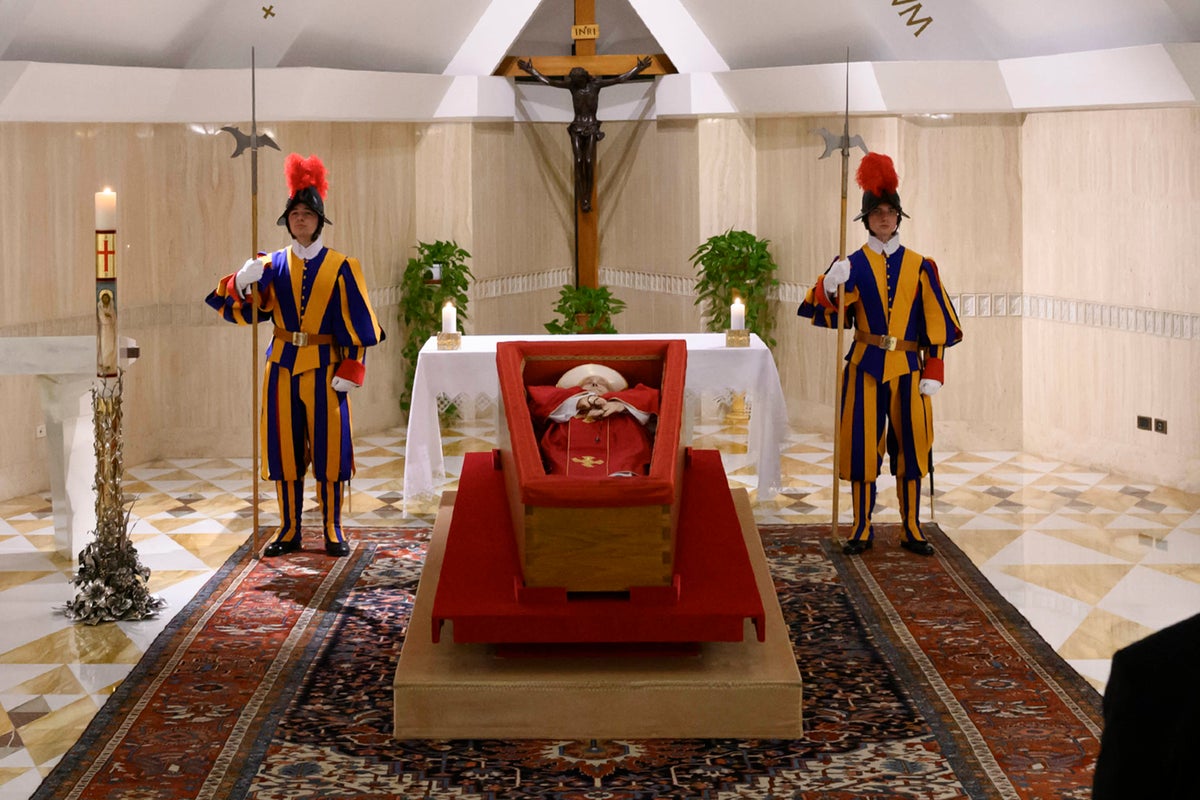Since Pope Francis’s death on Easter Monday, leaders from around the world have shared their tributes to the late pontiff, as 1.39 billion Catholics across the globe enter mourning.
Cardinals congregated the following day to establish the date of the funeral ahead of the papal conclave in which a new pope will be selected.
The pontiff had broken from tradition as he requested to be buried outside of Vatican grounds at the Basilica of Saint Mary Major in Rome, with the inscription of his papal name in Latin: Franciscus.
Nevertheless, the mourning process is set to keep in with centuries worth of tradition, including the Novemdiales – or nine days of mourning – which allegedly dates back to Roman times.
Pope Francis, 88, died following a stroke that led to a coma and irreversible heart failure, the Vatican announced.
The pope was hospitalised for several weeks in February, after suffering from double pneumonia. He returned to the Vatican in mid-March to recover.
As the first pope from Latin America, Pope Francis had led the 1.4 billion-member church since 2013.
Here is the timeline of events from the pope’s death and what will happen going forward.
20 April 2025 – the pope’s final public appearance
The day before the pope died, he carried on working through Easter Sunday. Francis even made a public appearance, his first since he was discharged from Gemelli hospital after five weeks with double pneumonia, as he went out into St Peter’s Square in the popemobile.
He was originally hesitant to make the surprise appearance, asking his 24-hour personal health care assistant, Mr Strappetti: “Do you think I can manage it?”
But once he was in the Square, he embraced the crowd in a poignant moment of his last outing. He would say to Mr Strappetti: “Thank you for bringing me back to the Square.”
21 April 2025 – Pope Francis dies aged 88 on Easter Monday
The Vatican announced that Pope Francis had died early on Monday morning at 7.35am. The camerlengo, Cardinal Kevin Farrell, announced his passing two hours later to the rest of the world via the Vatican’s news outlet.
It was later revealed that the pope suddenly fell ill at 5.30am before slipping into a coma. His cause of death was due to a stroke and irreversible heart failure.
Later that day, his death certificate was dealt with and the placement of the coffin was organised in the chapel on the ground floor of his residence in the Casa Santa Marta.
They also placed seals on the papal apartment on the third floor of the Apostolic Palace and on the apartment on the second floor of Casa Santa Marta, where the pope had resided.
As camerlengo, Cardinal Farrell will take care of the Holy See’s financial and administrative duties in absence of a pope while a papal conclave is underway.
22 April 2025 – the first General Congregation of Cardinals takes place
The first General Congregation of Cardinals took place, during which they decided when Francis’s funeral would take place. This marked the beginning period of prayer, reflection and preparation following the pope’s death.
In the evening, a Rosary took place in St Peter’s Square, inviting the faithful to join in prayer for Francis.
23 April 2025 – Pope Francis’s coffin is taken to lie in state
Pope Francis’ coffin will be taken to St Peter’s Basilica to lie in state for three days, when the public will be able to pay their respects.
The public will be allowed to pay their respects at 11am on Wednesday and the basilica will remain open until midnight.
Mourners can also enter between 7am and midnight on Thursday and between 7am and 7pm on Friday.
26 April 2025 – The funeral service and the nine day mourning period begins
The funeral service will take place in St Peter’s Square from 10am before he is taken to St Mary Major for burial. A nine-day period of mourning starts.
Dozens of world leaders and cardinals are set to attend, while the dean of the College of Cardinals, Giovanni Battista Re, will lead the service.
He will deliver the final commendation at the end of the service, which formally entrusts the pope to God before burial.
The coffin will be taken inside the basilica for the conclusion of the service, before it is then transported to his place of burial.
Pope Francis chose St Mary Major as his resting place, about 4 km from the Vatican.
The basilica was important to the pope because it was his favourite place to pray. He prayed there before and after every international trip.
“I’ve always had a great devotion to St Mary Major, even before I became pope,” he wrote in his 2024 book El Sucesor.
The last pope who was not buried on Vatican grounds was Leo XIII in 1903.
6 May 2025 – the earliest date the papal conclave can begin
The conclave to elect a new pope typically begins between 15 to 20 days after the pope’s passing. Cardinals are expected to give an exact date after the funeral.
The process of election is shrouded in secrecy, and it’s believed to be virtually unchanged in 800 years.
Under the current rules, only cardinals below the age of 80 are allowed to cast a vote.
Officially candidates for pope need only be male and Catholic, although in reality, pontiffs have only ever been chosen from the ranks of cardinals for centuries.
The 135 cardinals of voting age will gather inside the exquisitely decorated Sistine Chapel – home of all the Papal Conclaves since 1858, where they will whittle down candidates through successive rounds of voting.

